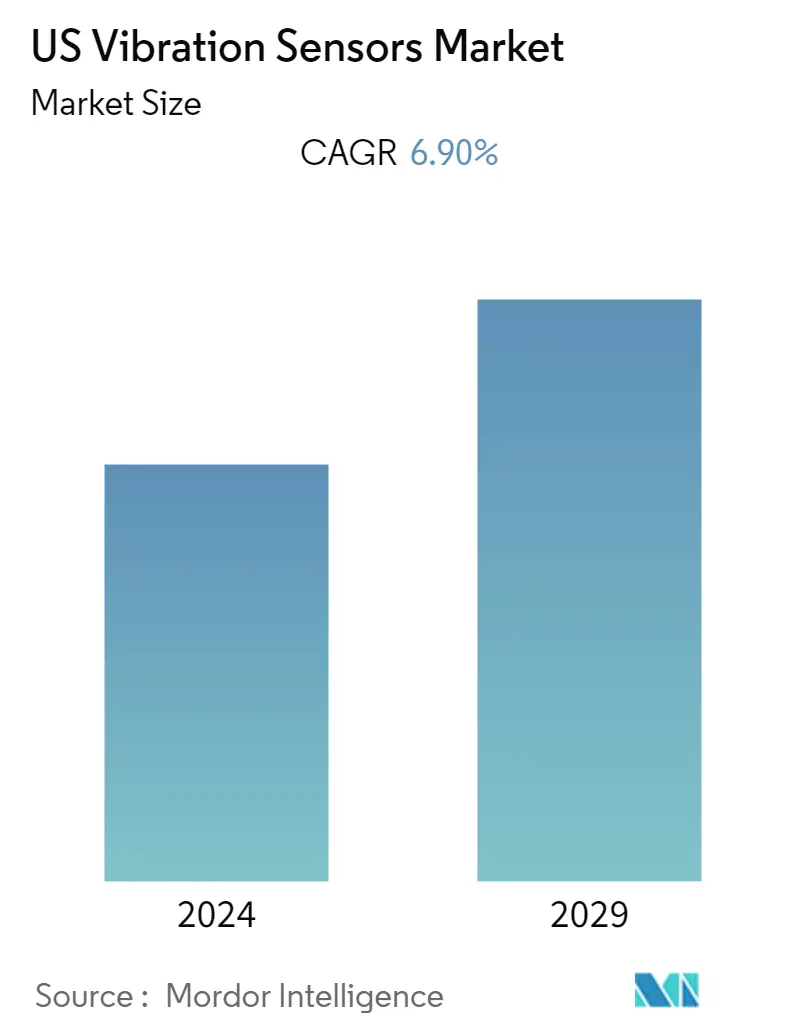Market Size of US Vibration Sensors Industry

| Study Period | 2019 - 2029 |
| Base Year For Estimation | 2023 |
| Forecast Data Period | 2024 - 2029 |
| Historical Data Period | 2019 - 2022 |
| CAGR | 6.90 % |
| Market Concentration | Low |
Major Players.webp)
*Disclaimer: Major Players sorted in no particular order |
US Vibration Sensors Market Analysis
The United States Vibration Sensors market is expected to register a CAGR of 6.9 % during the forecast period (2021-2026). Housing prominent automakers (over 13 major auto manufacturers) and vendors offering vibration sensors in the region are expected to emerge as sources for innovation and are expected to hold a prominent market share.With changing dynamics in the automotive industry, manufacturers are moving toward electric vehicle production to meet next-generation consumers' needs.
- There is an increased use of electric vehicles in the United States, with an estimated 1% of automotive sales in the US market. This is set to significantly augment the demand for MEMS sensors designed for automotive applications.
- Moreover, companies in the region are also growing due to high demand from the oil and gas sector within and outside the United States. The largest global producers of oil are the United States, Russia, and Saudi Arabia. The leading companies in the market focus on providing an overall solution to these high-growth markets such as these. According to Baker Hughes, the number of oil and gas wells to be drilled in the United States is expected to reach a count of 22,600 by 2022.
- According to Environment Impact Assessment, most US oil and natural gas production comes from wells that provide between 100 barrels of oil equivalent per day (BOE/d) and 3,200 BOE/d. This will have an impact on oil prices. Therefore the industry is leveraging technology to automate processes and for optimal maintenance of heavy machinery. This is further expected to enhance the growth prospects for vibration sensors.
- However, The spread of COVID-19 has disrupted global financial and commodity markets and the US oil and gas industry, now showing a decrease in energy demand. In an industry used to the highs and lows of economic and commodity price cycles, the year 2020 poses great challenges to oil and gas companies, and there might be a financial cut in terms of investments in technology and thus vibration sensors.
- In order to cater to the rapidly increasing demand, the major players are trying to maintain their dominance through strategic partnerships, mergers, acquisitions, and product innovations.
- For instance, in June 2020, Apple Inc. previewed watchOS 7, delivering enhanced customization tools and robust health and fitness features to one of the most advanced smartwatches. By detecting micro-movements from the device's accelerometer, that signals respiration during sleep. The watch intelligently captures when the user is sleeping and the sleeping time for every night. The user will see a visualization of their previous night's sleep, including periods of wake and sleep in the morning. It will also show a chart of their weekly sleep trend.
US Vibration Sensors Industry Segmentation
The United States Vibration Sensors Market is segmented on the basis of Type (Accelerometers, Electrodynamic Velocity Transducer, Non-Contact Displacement Transducer), By Material (Doped Silicon Sensors, Piezoelectric Ceramics, Quartz), By Technology (Hand Probes, Piezoelectric, Piezoresistive Sensors, Strain Gauge Sensor, Tri-Axial Sensor, Variable Capacitance Sensors) By Application (Aerospace, Automobile, Coal Mining and Quarry, Consumer Electronics, Food, Machine Monitoring, Medicine, Oil and Gas and Others).
US Vibration Sensors Market Size Summary
The United States vibration sensors market is poised for significant growth, driven by advancements in various sectors such as automotive, oil and gas, aerospace, and consumer electronics. The automotive industry, with its shift towards electric vehicles, is expected to boost the demand for MEMS sensors, which are crucial for automotive applications. The oil and gas sector, a major consumer of vibration sensors, is also experiencing increased demand due to the need for automation and optimal maintenance of heavy machinery. Despite challenges posed by the COVID-19 pandemic, which disrupted global markets and led to decreased energy demand, the market is witnessing strategic partnerships and innovations aimed at maintaining dominance and catering to the growing demand.
In the aerospace and defense sectors, the demand for accelerometers, particularly those based on MEMS technology, is on the rise due to their application in navigation, guidance, and control systems. These sensors are essential for ensuring operational specifications and are increasingly used in military applications. The consumer electronics sector also contributes to the market's growth, with vibration sensors being utilized to enhance device functionality and user experience. The competitive landscape is marked by the presence of major players who are expanding their market share through innovative products and strategic acquisitions. Companies like TE Connectivity and Yokogawa are leading the charge with new offerings that cater to diverse industry needs, further propelling the market's expansion.
US Vibration Sensors Market Size - Table of Contents
-
1. Market Segmentation
-
1.1 Product
-
1.1.1 Accelerometers
-
1.1.2 Proximity Probes
-
1.1.3 Tachometers
-
1.1.4 Others
-
-
1.2 Industry
-
1.2.1 Automotive
-
1.2.2 Helathcare
-
1.2.3 Aerospace & Defence
-
1.2.4 Consumer Electronics
-
1.2.5 Oil And Gas
-
1.2.6 Metals and Mining
-
1.2.7 Others
-
-
US Vibration Sensors Market Size FAQs
What is the current US Vibration Sensors Market size?
The US Vibration Sensors Market is projected to register a CAGR of 6.90% during the forecast period (2024-2029)
Who are the key players in US Vibration Sensors Market?
National Instruments Corporation, Texas Instruments Incorporated, SKF GmbH, Emerson Electric Co. and Honeywell International Inc. are the major companies operating in the US Vibration Sensors Market.

